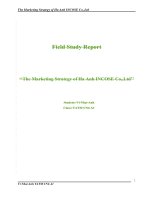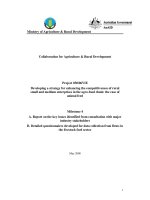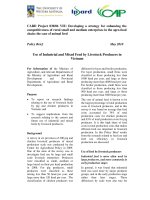28 DEVELOPING BRANDING STRATEGY AT SIX COLORS PRINTING CO , ltd
Bạn đang xem bản rút gọn của tài liệu. Xem và tải ngay bản đầy đủ của tài liệu tại đây (938.44 KB, 55 trang )
ACADEMY OF FINANCE
----------
Student: LE MAI ANH
Group: CQ55/51.01
GRADUATION THESIS
TOPIC:
DEVELOPING BRANDING STRATEGY
AT SIX COLORS PRINTING CO., Ltd
Major
: English for Finance and Accounting
Student code: 17522202010002
Supervisor : Mrs. Phan Thi Ha My M.A.,
Ha Noi – 2021
1
DECLARATION
I, Le Mai Anh, being a student of the Faculty of Foreign Languages, hereby certify
my authorship of the thesis submitted today entitled: “Developing branding strategy
at Six Colors Printing Co., Ltd.”
I declare that the thesis and the study presented in it are my own and have been
generated by me as the result of my own original research.
Hanoi, May, 2021
Student
LE MAI ANH
Lê Mai Anh-CQ55/51.01
Page 2
ABSTRACT
This study examines the developing branding strategy processes at Six Colors
Printing Company. The article aims to find out strategies to develop the brand and
more importantly, propose the main methods to improve business performance at
the company. To achieve these goals, the graduate paper will review the current
strategy within the company and indicate whether those campaigns are effective.
From the obtained results, the study gives the most practical meaning to Six Colors
Printing Company to improve brand efficiency and improve business performance
at the company.
Lê Mai Anh-CQ55/51.01
Page 3
ACKNOWLEDGMENTS
I would like to express my sincere thanks to all those who made it possible for
me to complete this graduate thesis. In the process of preparing this graduation
thesis, I have received the support and guidance of teachers, colleagues, family and
friends. I would like to express my deep gratitude to all of them. First of all, I would
like to express my deepest gratitude to Mrs. Phan Thi Ha My M.A., lecturer at the
Academy of Finance, for her guidance. I wholeheartedly appreciate that your advice
for my research helped me a lot to complete this research. I also thank the members
of Six Colors Printing Company for their great support during the internship. I am
extremely grateful and grateful to them for sharing their expertise, as well as their
sincere and valuable guidance and encouragement. Finally, I would like to express
my sincere thanks to my family, who always love and care about me mentally and
physically, encouraging me to complete the thesis.
Lê Mai Anh-CQ55/51.01
Page 4
LIST OF ABBREVIATIONS
1. SWOT: Strengths, Weaknesses, Opportunities, and Threats
2. VND: Vietnam Dong
3. %: percent
4. Co., Ltd: Limited company
Lê Mai Anh-CQ55/51.01
Page 5
LIST OF FIGURES AND TABLES
Lê Mai Anh-CQ55/51.01
Page 6
TABLE OF CONTENTS
Lê Mai Anh-CQ55/51.01
Page 7
INTRODUCTION
1. Rationale of the study
Nowadays, a strong brand must be attractive to customers and the public can
be seen as the symbol and line of every company. Therefore, each brand sets its own
standards and must constantly strive to satisfy customers' needs, especially with
sensitive groups of customers receiving the brand's progress. The brand's standards
and messages must be widely publicized, thereby demonstrating the product's
differentiation from those of competing businesses.
Therefore, in the production and business process, businesses need to
strengthen brand development. Building and developing a brand is a long process, it
not only lasts a period or a period, but it is also always associated with the lifespan
of the company, it takes even longer than that. The issue of branding in the printing
industry is being paid special attention by many products in the period of product
competition. Often people talk about competition between firms, between brands of
the printing industry rather than talking about competition between products. The
printing industry's brand name is not merely distinguishing between one product
from another, one service from another, but also affirms the enterprise's position in
the market. Moreover, building the brand name printing industry has a position in
the market, it is necessary to develop a brand name in the market. How to build and
develop a brand for the printing industry strategically is even more difficult. All
printing businesses are born with strategies, but how to make them efficient, longterm, saving costs and resources is a difficult problem.
Currently, there are many businesses with very correct brand awareness and
methodical investment to have a clear strategy. But the business environment is
always changing, so there are factors that are strong enough for the brand to change
and develop to adapt to those changing factors. The color printing brand of Six
Colors Printing Co., Ltd. has been established for almost 4 years, so it has built-in
the market for many years with the company's business, up now, it has achieved
certain goals compared with the strategy. In order to develop besides consolidating
Lê Mai Anh-CQ55/51.01
Page 8
the system from production to consumption, the company must also research to
perfect its brand strategy.
But nowadays there are many factors affecting the brand, so the company
needs a more proper brand development strategy to adapt to the impact factors.
Also, for that reason, I chose the topic: "Developing branding strategy at Six Colors
Printing Co., Ltd." to research.
2. Aims of the study
The study was aimed at understanding the current situation of branding
activities at Six Colors Printing Company, from which proposing solutions to
develop an appropriate branding strategy for the company. The author wanted to
focus on answering the two following questions:
• What was the current situation of branding activities at Six Colors Printing
Company?
• What should be done to develop an appropriate branding strategy at Six Colors
Printing Company?
3. Scope of the study
Because of the time limitation and the scale of the research, as well as for the
thoroughness of what was done, the research was conducted with the participation
of 2 managers, 31 staff from the Business department, and over 50 customers
including both big and small organizations or both old and new customers in the
fiscal year 2019 – 2020
4. Methodology of the study
The study was done with the employment of two methods, including
documentary review and questionnaire survey.
Firstly, the data was gathered from books, newspapers, magazines, textbooks
of professors and doctoral research on the subject area as well as financial
statements, profit and loss reports, and balance sheets are obtained from a company
and other trustworthy sources.
Second, a questionnaire survey was designed on the basis of 4Ps, a marketing
mix strategy developed by Principles of Marketing (Philip Kottler, 2005), to collect
Lê Mai Anh-CQ55/51.01
Page 9
information about current branding activities at Six Colors Printing Company from
employees and customers. There were 3 questions in the questionnaire. The first one
was to collect information about current branding activities at Six Colors Printing
Company. The second was to find out the effectiveness of current branding
activities of the company: brand image, aided brand awareness, the brand strategy
must have a clear purpose. The third one was to find out solutions to develop an
appropriate branding strategy, recommended by customers, staff.
In addition, SWOT analysis, developed by Albert Humphrey (1960), was also
employed to understand the strengths and weaknesses of current branding strategy
at Six Colors Printing Company, from which, identify the opportunities as well as
the threats.
5. Organization of the study
Apart from Introduction, Conclusion, Reference, and Appendixes the main
content of the study was divided into three chapters as below:
Chapter 1: LITERATURE REVIEW provides a general overview of basic theories
of branding development.
Chapter 2: THE STUDY provides a vast picture of Six Colors Printing Company
situation in branding development in reality
Chapter 3: RECOMMENTDATIONS provides some proposals to the company in
terms of developing the company’s brand further.
Lê Mai Anh-CQ55/51.01
Page 10
Lê Mai Anh-CQ55/51.01
Page 11
CHAPTER 1: LITERATURE REVIEW
1.1. Overview on developing branding strategy in Vietnam printing industry
1.1.1. Overview on branding strategy
1.1.1.1. Definition of brand, branding strategy
Brand
In Vietnamese Marketing book gives the information of brand which means
“brand is a cultural, emotional, intuitive and exclusive image that customers
associate when referring to a product or a business.” (Brand management of The
Academy Of Finance).
A brand is the set of characteristics that makes your offering stand out to
customers (Neil Russell Jones & Lynne Jones, 2014)
A brand is typically comprised of a name, tagline, logo or symbol, design,
brand voice, and more. It also refers to the overall experience a customer undergoes
when interacting with a business — as a shopper, customer, social media follower,
or mere passerby (HubSpot’s blog, 2020)
Brands refers to the aspirations and a desirable image of life that customers
would like to identify with (Tonya Trippe, 2007).
Brand refers to a business and marketing concept that helps people identify a
particular company, product, or individual (Will Kenton, 2020)
Branding strategy
According to a Marketing website: “Brand strategy defines what you stand
for, a promise you make, and the personality you convey. And while it includes your
logo, color palette, and slogan, those are only creative elements that convey your
brand. ”
A brand strategy defines rules and guidelines on how, what, where, when, and
to whom you communicate your brand messages (Cliff Callis, 2018)
A brand strategy refers to “a formal plan used by a business to create a
particular image of itself in the minds of current and potential customers. When a
Lê Mai Anh-CQ55/51.01
Page 12
company has created and executed a successful brand strategy, people know without
being told who the company is and what they do.” (Kasza, 2015)
In conclusion, combined with the brand strategy definition above, the
following brand strategy can be drawn: "A brand strategy by definition is a longterm plan for the development of a brand to achieve its specific goals. A welldesigned brand strategy can help improve business in various ways, such as
connecting with consumer needs and emotions and enabling you to succeed in a
competitive environment." (Limelight Marketing, 2015).
1.1.1.2. Types of branding strategy
A company has five choices when it comes to developing brands. It can
introduce brand extensions (existing brand names extended to new product
categories), individual randing, derived brands,Attitude Branding and Iconic Brands
or private labels (new brand names in new product categories). According to the
Oxford English for Marketing and Advertising
Brand Extension
The existing strong brand name can be used as a vehicle for new or modified
products. For example, many fashion and designer companies extended brands into
fragrances, shoes and accessories, furniture, and hotels. Frequently, the product is
no different than what is already on the market, except it has a brand name marking.
An example, Starbucks introduced their k-cups for coffee drinkers who are looking
to enjoy the benefits of Starbucks' gourmet coffee at home or at the office. Below is
an image that showcases Starbucks' strategic implementation of multiple brand
strategies. Not only have they used the brand extension strategy in order to serve
customers at the convenience of their homes or offices, but they also introduced a
line extension now known as, Blonde Roast.
Individual Branding
Each brand has a separate name, putting it into a de facto competition against
other brands from the same company (for example, Kool-Aid and Tang are both
owned by Kraft Foods). Individual brand names naturally allow greater flexibility
Lê Mai Anh-CQ55/51.01
Page 13
by permitting a variety of different products, of differing quality, to be sold without
confusing the consumer’s perception of what business the company is in or diluting
higher quality products.
Derived Brands
Some suppliers of key components may wish to guarantee their own position
by promoting that component as a brand in its own right. For example, Intel
positions itself in the PC market with the slogan (and sticker) “Intel Inside. ”
Attitude Branding and Iconic Brands
This is the choice to represent a larger feeling, which is not necessarily
connected with the product or consumption of the product at all. Companies that use
attitude branding include: Nike, Starbucks, The Body Shop, and Apple, Inc. Iconic
brands are defined as having aspects that contribute to the consumer’s selfexpression and personal identity.
Brands whose value to consumers comes primarily from having identity value
are said to be “identity brands. ” Some brands have such a strong identity that they
become “iconic brands” such as Apple, Nike, and Harley Davidson.
Private Labels
Also called own brands, or store brands, these have become increasingly
popular. Where the retailer has a particularly strong identity this “own brand” may
be able to compete against even the strongest brand leaders and may outperform
those products that are not otherwise strongly branded.
1.1.1.3. Activities to develop a branding strategy
A brand that aspires to convey values, mission and vision. It's the nature of
business and the way the brand is communicated to the customes.
Identifying brand vision
Brand vision is the goal that the brand wants to achieve in a certain period of
time. Brand vision is like a shot signaling the appearance or expansion of the brand
to the market and customers, in order to create direction for the brand strategy and
affirm its position on the market map.
Lê Mai Anh-CQ55/51.01
Page 14
Building brand identity system
The logo design must reflect the outstanding features of the brand, the message
conveyed and the business line. Combine colors, images and lines of the logo so
that it is harmonious and attractive. In addition, the logo is marked on the product to
create a highlight to help customers easily identify.
Having marketing steps to develop brand
Product quality remains the most important strategic factor for companies
looking to build and develop long-term value-added businesses. Good product
quality helps consumer trust and businesses in gaining new potential customers
based on the feedback of existing customers.
Along with good product quality, the customer care policies of the business are
always put on top to help the business develop and bring its brand closer to
customers. Some common policies of businesses are pricing policies, promotions,
discounts, customer gratitude events. These policies also cover customer service,
shipping policies, warranties, and maintenance. All policies are focused and
directed by the company in order to bring customers the best satisfaction and
experience.
1.1.1.4. The importance of branding strategy
The role of brand to the business.
Firstly, the brand helps to recognize and distinguish the products of the
business,
increasing
competitiveness.
Through
branding,
consumers
and
manufacturers can easily distinguish the goods of one business from another.
Brands also play an important role in segmenting a business's market. When goods
are richer and more diverse, the distinguishing function becomes more important.
The stronger the brand, the higher the competitiveness of the business.
Secondly, the brand has an informative and instructive role. The informational
and instructive function of the brand is shown in that: through images, language, or
other signs, consumers can partially recognize the use-value and utility of the
Lê Mai Anh-CQ55/51.01
Page 15
goods. The information about the place of production, the class of the goods as well
as the conditions of consumption ... are also partly expressed through the brand.
Thirdly, the brand creates perception and trust for customers and partners. This
function is the consumer's perception of difference, superiority or peace of mind,
comfort, and trust when consuming goods and services when the choice that the
brand brings is formed a combination of brand elements such as colors, names,
logos, sounds, slogans, and consumer experiences. An accepted classy brand will
create trust, commitment to customers and customers will be loyal to that brand and
service.
Fourthly, the brand is an important asset of the business, bringing many
economic benefits to the business. The brand is considered an intangible and very
valuable asset of a business. The value of the brand is difficult to determine, but
thanks to the advantages that the brand brings, goods and services will be sold
more, even at higher prices, easier to penetrate the market. The profit and potential
that the business has from the popularity of the brand will determine the financial
value of the brand.
Fifthly, the brand helps attract investment. Famous brands not only create
certain advantages for businesses in the process of selling and providing services
but also facilitate and as a guarantee to attract investment and increase sales
relationships. row.
And the last, the brand is a tool to protect the interests of businesses and
society. Trademarks are understood to include a number of industrial property
objects such as trade names, trademarks. After these objects are protected by the
state by the provisions of the law, the legal owner is the enterprise may exploit all
benefits from the brand as well as have the right not to allow others to use its
trademark. State-protected trademarks also help prevent counterfeit and counterfeit
products from being sold in the market, encourage consumer psychology of
reputable products, and satisfy consumers' satisfaction with product quality.
The role of brand to the customer.
Lê Mai Anh-CQ55/51.01
Page 16
Trademarks identify the source of a product or manufacturer, helping
customers identify a specific manufacturer or distributor responsible for a product
traded in the marketplace. When consuming a product, thanks to the experience in
the use process combined with the marketing programs of that product over many
years, customers know and maintain the use of the brand. They know which brands
satisfy their needs and which do not. As a result, branding becomes a tool to quickly
and simply simplify the customer's purchasing decision. This allows customers to
reduce the cost of time and effort searching for products. This is the most important
thing that a brand that a business associated with that brand should aim for. Some
brands are associated with people or a certain type of person to reflect different
values or different personality traits. Therefore, the brand can be seen as a symbolic
tool for customers to affirm their self-worth. Young customers feel more stylish and
trendy in Nike products, others want the image of a dynamic and successful
businessman with Mercedes. The role of the brand is really important in signaling
the characteristics and attributes of the product to the consumer, with reliable
products and experiences of attributes that are difficult to discern through external
signs, the brand becomes a single important sign of quality for easier identification
by consumers. Brands can also reduce the risk for customers when they decide to
buy and consume a product by buying well-known brands, especially those that
have brought them good experiences in the past. Therefore, brand is also an
important risk management tool for customers.
1.1.2 Branding activities of businesses in printing industry in Vietnam
1.1.2.1. Printing industry in Vietnam
The printing industry is one of the manufacturing industries at the forefront of
adopting change in technology. Technology adoption is rapidly shifting from
traditional to digital printing. Print companies are ramping up their capabilities with
newer technologies and are investing in a seamless workflow as an inbuilt ability to
drive innovation and dramatically improve efficiency. Thus, the industrial
revolution has ushered in a new era for the professional printing industry, with the
Lê Mai Anh-CQ55/51.01
Page 17
introduction of a multitude of new technologies that are leading printing to
perfection and development.
The fact that businesses do not change in time with the times will be changed
by companies with great potential and spend most of the market, especially in the
market for printing packages and labels, then it is difficult for small companies to
exist. In the past, the Vietnamese printing industry only had state-owned enterprises
participating in the market, at that time, technology innovation might take place
slowly but without much impact as the total market was still divided among
enterprises. But today, there are many types of businesses participating including
foreign enterprises with great potential, when they innovate according to
industrialization they will dominate most of the market, no longer share for
businesses the industry does not have the ability to innovate.
Along with the strong recovery and growth in consumer demand, economy and
world trade in the coming years, especially in the context of increasingly fierce
brand competition among businesses in the same industry, demand Global printing
demand is forecast to increase markedly. According to the Freedonia Group, the
demand for brands in the world will increase by 4.3% / year with a total output of
up to 49 billion m2 and the sales of finished products in the market is expected to
reach USD 105 billion.
In Vietnam, the growth rate of the printing industry in the past two or three years
has also reached a high level of 15-20% / year, accounting for 8-10% of the
country's GDP. With the high economic growth rate and the number of new
businesses increasing every year, it is likely that the growth rate in this field will
continue to reach a high level in the coming years, at over 20% per year.
However, most Vietnamese printing companies are small and medium-sized
companies, so their professionalism is not high. Therefore, the integration into the
WTO is a quite big challenge for Vietnamese enterprises today, requiring the
Vietnamese printing enterprises to invest in improving the qualifications of people,
technology and machines equipment to compete with foreign businesses.
1.1.2.2. Activities to develop brand of businesses in printing industry in Vietnam
Lê Mai Anh-CQ55/51.01
Page 18
A printing business that wants to develop a brand name in the Vietnamese
market can use one or a combination of different methods such as:
Repositioning the brand
The brand has been positioned in the market with certain positions over time,
the environment changes, and the positioning is no longer suitable for the business
situation of the enterprise or not suitable for the competitive environment.
Enterprises need to consider the positioning factor to make repositioning changes in
accordance with the business environment, the internal factors of the business in
order to develop an appropriate brand strategy. Using communication tools
(advertising, public relations, marketing ...) to increase the perceived value and
brand awareness from the public, in order to build a brand image in the customer's
mind. contribute to improve the effectiveness of brand positioning.
Increase awareness
The concept of brand has clearly indicated that brand is to distinguish products
and goods between different products and services. So the core of the brand is to
identify the product, it is impossible to say a strong brand when customers do not
recognize or in other words have no awareness of the business' products and
services. Therefore, one of the factors to evaluate brand value is the brand
awareness of customers. Increasing brand awareness through the company's brand
identity system through elements such as logo, sologan, products and services... A
brand with a uniform brand identity system will easily attract customers goods and
more aware. Currently, some franchise businesses transfer the right to use the brand
identity system, business secrets, products and services to third parties to use to
attract customers. This not only makes the brand more recognizable, goes into
customers' minds faster, and also brings revenue to the franchisee. It also means that
the franchise brand must be a strong and influential brand in the market.
Increase perceived value
Brand perceived value is assessed through the process of using, customers
perceive product quality, product use value quality associated with associations.
Products often use brand images that have been associated with certain positions in
Lê Mai Anh-CQ55/51.01
Page 19
the customer's psychology associated with these positions. Some examples can be
mentioned such as the luxury of the product, or the product for young people that is
communicated by young stars to create a feeling of closeness and friendliness.
Brand extension
Brand extensions are often used when a product has been successful and has
certain associations in the customer's mind. Then use that brand for products with
similar functional uses. Enterprises expand the product spectrum, create a
synergistic effect for added brand value, in order to increase the business goals of
the business as well as associate customer loyalty with the brand.
Brand extensions are divided into two main types: sub-brand extensions and
new-brand extensions. Sub-brand extension is the development of a new brand
based on old products that change in size, packaging, and flavor, but in essence still
have the same original use value. Expanding the brand into other products mainly
takes advantage of the brand that has a good reputation in the market to expand to
other products and services with the same target customers. The extended product
still uses the old brand name but has the same use value as the old product or has a
brand association that has been positioned in the minds of consumers similar to the
product already on the market.
Brand Refresh
Through changing the brand identity system or refreshing through splitting and
merging, creating a new feeling with the brand for businesses and consumers.
Changing or adjusting the brand identity system means changing or adjusting the
elements of the brand identity system such as brand name, logo, sologan, color of
the brand identity system or elements such as: label packaging. This change is based
on factors of consumer tastes.
1.2. Measurement and assessment of a branding strategy
1.2.1. Methods of assessing the effectiveness of branding strategy
Brand image
A brand image can consist of: Logo, the main, colors, the style of images, graphics,
typography. These elements combined serve as a guideline for consumers. Being
Lê Mai Anh-CQ55/51.01
Page 20
consistent gives consumers a clear idea of who you are and what you have to offer.
It ensures that the message delivered to the customer and the brand identity
elements are relevant. It also creates a common standard for brand judgment by
customers. Consistency in brand strategy helps increase customer loyalty to the
brand.
The brand strategy must have a clear purpose
Defining goals is the first step and cannot be ignored when a business develops a
strategy that helps brands create value different from their competitors. Good goals
need to be highly workable and measurable.
The brand strategy must be flexible
In a day-to-day changing business environment, a strategy needs to be adaptive to
survive and thrive. Flexibility allows brands to maximize creativity in media
campaigns. It also helps in expanding the product portfolio or reaching new target
groups.
The brand strategy must be decided by the staff
No matter how strong a strategy is, people are still the core determining factor.
Employees are the ones directly implementing those campaigns. Therefore, it is
necessary to train and maximize the existing employees' human resources. In
addition, the staff is also a great communication channel that businesses should pay
attention to.
1.2.2. The SWOT analysis
Within the research scope, the thesis will give a SWOT analysis model
including Strengths, Weaknesses, Opportunities and Threats to analyze strategy.
According to Albert Humphrey (1960), SWOT analysis is an analysis of internal
factors (Strengths and Weaknesses) and external factors (Opportunities and Threats)
of a company. SWOT allows the analysis of various factors that have a relative
influence on brand competitiveness.
Lê Mai Anh-CQ55/51.01
Page 21
Figure 1.2: SWOT Analysis
The first element of a SWOT analysis is Strengths. This element describes
what a company excels at and what sets it apart from the competition: a strong
brand, a loyal customer base, a strong balance sheet, unique technology, and so on.
Once the company has identified its strengths, the next critical step is to identify its
weaknesses. Weaknesses are things that prevent an organization from performing at
its best. A weak brand, higher-than-average turnover, high levels of debt, an
inadequate supply chain, or a lack of capital are examples of areas where the
company must improve in order to remain competitive. The next is Opportunities.
This element refers to external factors that may provide a competitive advantage to
a company. The last, Threats are factors that have the potential to cause harm an
organization.
SWOT Analysis is thought to be an important tool for a company to keep track
of its own activities and to determine where it stands in the market.
1.2.3. The 4Ps
Marketing Mix is one of the most important marketing strategies used by
companies. "Marketing Mix is the combination of four elements, called the 4P's
(Product, Price, Promotion, and Place), that every company has the option of
Lê Mai Anh-CQ55/51.01
Page 22
adding, subtracting, or modifying in order to create a desired marketing strategy".
(Philip Kotler,1987)
Product
What is being sold. Marketers must consider the life cycle of the product to
address any challenges that may arise once it's in the hands of the consumer. For
example, the earliest version of the iPod had a battery life problem that was only
noticeable after a certain amount of time, and Apple needed to develop ways to
combat that problem.
Price
The cost to purchase a product. Price depends on the customer's perceived
value of the product, and it can dramatically change your marketing strategy. A
lower price makes a product accessible to more customers, while a higher price
appeals to customers seeking exclusivity. Either way, the price must be greater than
the cost of production so your business can make a profit.
Place
Talk about product distribution channels. A distribution channel can be an
organization or individual involved in the process of bringing a product from the
producer to the consumer. In addition to direct sales to consumers, businesses can
distribute through intermediary distributors such as wholesalers, retailers, agents,
brokers... Distribution channels decide whether products can reach with consumers
or not.
Promotion
Firstly, there are some common policies of businesses: pricing policies,
promotions, discounts, customer gratitude events. These are usually short-term
strategic activities which aim to encourage a surge in sales. These could be ‘buy one
get one free’ options, seasonal discounts, samples or even special coupons with
expiration dates. Secondly, direct Marketing targets specific influential potential
users through telemarketing, customized letters, emails and text messages. In
addition, these policies also include customer care, shipping policy, warranty,
Lê Mai Anh-CQ55/51.01
Page 23
maintenance. If these customer policies are implemented well and satisfy every
customer, the brand's reputation can spread quickly.
1.3. Factors affect the effectiveness of a branding strategy
1.3.1. Internal factors
Labor force
Labor is one of the important input factors. It participates in all activities, all
stages and all business processes of the business. The qualifications, capabilities and
sense of responsibility of the employees directly affect all stages of the production
and business process. Employees' characteristics have a direct impact on
productivity, quality, and speed of product consumption, so it directly affects the
efficiency of production and business of enterprises. Especially in order to build a
strong brand, the workforce must reach a certain level to be effective. Enterprises
need to pay special attention to this issue.
Financial capacity
Enterprises need to have strong financial capacity to ensure the continuous
and stable branding of their activities. The financial ability of the business directly
affects the reputation of the business. Enterprises must strongly invest a large
budget for the brand to achieve efficiency.
Infrastructure and equipment system
This is a factor that has a direct impact on the choice of the brand model and
the branding strategy of the business. Enterprise's infrastructure and equipment
system meeting the production requirements of quantity and product quality is a
prerequisite for enterprise decision-making.
Characteristics of products and services
In production and business, businesses are always looking for ways to
differentiate their products and design products with outstanding features to gain
market share. Products are not only diverse in types but also in appearance. This is
also the first factor affecting the buying psychology of consumers. Companies with
a reputation for providing good quality products often have a wide variety of
products. Durability and product quality are always important factors. No customer
Lê Mai Anh-CQ55/51.01
Page 24
wants to buy low-quality products, even if they are low-cost. In addition, the unique
style of the product is an equally important factor contributing to the branding
strategy. If a good product has a reasonable price but the design is not attractive,
perhaps it will not attract manifold customers.
Prices of products and services
The next factor affecting branding is the price of products and services. Brand
pricing can create mental contacts of different prices in the same product category.
Customers often rate brands according to price tiers within the same product
category. However, a brand with a high price may not be good and reputable
enough. Customers are only willing to spend large sums of money to buy products
on their behalf. It not only fulfills tangible needs but also intangible values.
Therefore, customers will focus on the distinctive features, attributes and
outstanding features of the product to accept the price offered by the business. The
selection of an appropriate pricing strategy should be determined on the basis of
current prices. And there must be a policy or regulation that is long enough for
promotions and discounts over time.
For example, when bringing a new product to market, a company could use market
penetration or price skimming strategy. In term of the penetration strategy, the
initial selling price and profit will be very low, even negative. In term of the price
skimming strategy, selling price will be as high as possible for segments ready to
accept new products. When consumption decreases, businesses will reduce prices to
attract more customers in the lower market segment. The condition is the high
demand for new products and high prices initially creating an image of high-end
products.
1.3.2. External factors
Market and customer
In general, the market is divided into two basic categories: the consumer
product market and the industrial product market.
There is a clear difference between competitive market research between brands and
products or product lines. Product market share can be determined based on market
Lê Mai Anh-CQ55/51.01
Page 25









